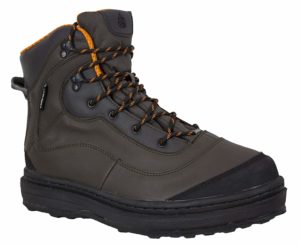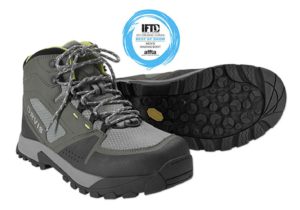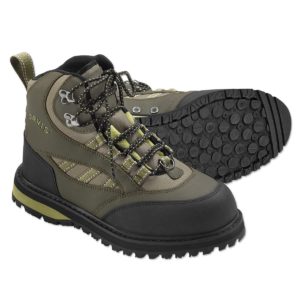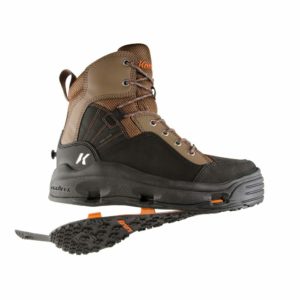You might have found this post if you were looking for waders. Don’t bounce back just yet it that is the case. First, I have an excellent review on waders, if I do say so myself, and, second, wading boots are a must-have if you use stockingfoot waders.
Wading boots do not provide the same level of water protection as waders, but that is hardly a problem given that they are used together. What they do instead is give you extra traction and reinforce the protection waders offer. Finally, you can’t exactly use a pair of your regular boats if you want to enter the water.
The question is, how to choose your wading boots? What factors must one account for? For that, you can refer to the Buyers Guide. But if you just one to find a pair of the best wading boots, feel free to check out my top picks.
Without further ado, here it comes!





Top 5 Best Wading Boots in 2019
1Redington Prowler Boots — Best Bang for the Buck
If I were to describe these boots in under 5 words, I would say “reasonably good wading boots.” As it is, I can share more words to relay my opinion of them.
First off, you can choose between two options. The Prowler Boots come with rubber soles and with felt soles. Take your pick.
For reference, I recommend that you check out my buyer’s guide section, but as it is, I advise getting rubber soles unless you have some specific requirements.
Is this the top pick? Unfortunately no. For wading boots, these are surprisingly quick to absorb water, and they stay wet for a long while. This is precisely what perfect wading boots should not do. They also run a size small. That’s not a real disadvantage, but it’s definitely something that you should know before you commit.
I never said that these were perfect, though. Reasonably good, more like. They are durable, after all, and well designed although somewhat bulky. But their relatively low price definitely helps. I also wouldn’t say they are uncomfortable, as they are anything but that.
Although you may not find a mention of that, the boots are stud compatible. So there’s that.
- Comfortable. These Prowler Boots are reasonably comfortable for wading boots.
- Well-designed. The manufacturers took their time to craft these boots.
- Stud-compatible. If you think you need better traction, you can install studs on these boots.
- Durable. If you want to walk around wearing these boots, go for it. They can handle that.
- Bulky. While they are well-made, it's painfully apparent these are wading boots.
- Absorb water. Not something you want your wading boots to do. Expect them to be a whole lot heavier after you get out of the water.
- Run a size small. Keep that in mind when choosing the size of the boots
2COMPASS 360 Wading Shoe — Cheapest Boots
If you think that the other wading boots are too expensive, try these boots. They are almost twice as cheap as most other boots on the list.
It doesn’t mean they are poorly made, even though not every customer remains satisfied with them. That said, they do offer extra protection for the toes and heels. It’s essential for wading, as you will find out from my Buyer’s Guide.
The outsoles are cleated, but that improves their performance only marginally. Still, it’s a bit better than pure rubber soles.
- Low price. Really cheap wading boots, although not as cheap as some of fewer quality options.
- Cleats. If you want excellent traction, the cleats will definitely improve their performance, if only a little.
- Toe and heel protection. With it, you don’t have to worry about bumping into something.
- Studs do not come with the shoes.
3Orvis Men's Ultralight Wading Boot — Lightest Boots
Weight is not one of the critical features of wading boots, but it doesn’t make weight any less grave.
These boots from Orvis are super lightweight, and that makes them comfortable to wear when you are not using them for fishing. The midsole is made from EVA, and EVA is definitely not worse than polyurethane. It’s just as light and just as capable of providing excellent support to ensure maximum comfort.
I wouldn’t say the boots are featherlight, but they are just as light as regular boots. The structure of the boots reinforces the quality of the boots since they don’t soak and water slides off the boots effortlessly.
The Orvis boots come with rubber soles, that makes them suitable for most terrains and also legal in every state.
- Mesh lining. While not a requirement for wading boots, it's definitely an excellent addition.
- Midsole support. Something you’re going to need a lot since these boots are more than suitable for using them like regular boots.
- Lightweight. Is there is a single reason to buy these boots, this is it
- A bit expensive. Say what you will, but I would expect something of this quality to be somewhat cheaper.
- Midsole support could be better. While the boots do provide midsole support, it is not as strong as could be.
- May be not large enough for your waders. If you have stockingfoot waders, you need your wading boots to be a little wider in the ankle than your actual size.
4Orvis Women's Encounter Wading Boot — Best for Women
Not many manufacturers care enough to make fishing gear for women. Thankfully, Orvis is not that brand.
The Encounter Wading Boots are made for ladies, although, men with smaller feet can wear them if they are not biased against such a thing, I suppose. The color scheme is definitely unisex enough for that. The “Women’s” part is more about the size than anything else. It’s not like wading boots are very variable when it comes to anything else except pure function.
Suffice to say, the functional features are designed quite thoroughly.
The Encounter Boots are quite cheap for wading boots, but they are high-quality and reliable. The manufacturer’s product description is packed with long words, but all they boil down to very few things: the boots have a good grip on most terrains, durable, and stud-compatible.
What’s more important, these boots are true to size, unlike the other Orvis boots on this list.
- Firm grip. Rubber soles are perfect for all terrains.
- True to size. While that’s something you would expect from any pair of boots, all too often run a size small or large.
- Midsole support. Good enough, although nothing outstanding.
- Specially made for female anglers.
- Little to no selection. It was hard to come up with any disadvantages for this pair of boots, and, come to think of it, the limited range is the only consistent drawback.
5Korkers Wading Boot — Most Stylish Wading Boots
Watertight is not a word to describe these boots. But that is not really a disadvantage. The point is, wading boots shouldn’t stay wet when out of the water, these Korkers boots do the job beautifully. First of all, they are complete with drainage ports and channels. But the top materials are also hydrophobic, which means they just don’t get wet on the surface.
The boots dry fast, but it’s far from the only advantage of theirs. They have a raised midsole and the reinforced toe cap. Midsoles are replaceable. However, I wouldn’t say that is an advantage. Instead, it’s trouble waiting to happen. Since the outsoles are replaceable, they may come off at the most inconvenient time without you intending it.
All in all, this is an extremely robust and durable pair of wading boots explicitly made for faster drying.
- Hydrophobic materials. The upper materials do not get wet, and that makes drying the boots so much simpler.
- Drainage ports and channels. Even though water will get into the boots quickly, it's not going to stay there.
- Midsole Support. Reasonably good, and definitely something you need.
- Reinforced toe cap. That’s one of the best features to have when you can’t see your own feet.
- Interchangeable soles. Usually, that would be a pro, but the replaceable outsoles are nothing else than a weak point. It's sure convenient when you can replace them, but they are going to be done for far sooner than regular soles.
Buyer’s Guide
The Material of the Boots
What are the boots made of? The answer to that question is more important than you might think. Depending on it, you may expect different traction on different surfaces, and then there is water tightness and warmth to consider.Wading boots are typically made of one of three materials: rubber, felt, and their combinations. They are not the only materials utilized in wading boots production, but they are definitely the most popular.Rubber soles tend to provide the best traction on most terrains, but calling all-rubber boots breathable is a considerable stretch. At the same time, even children know rubber is waterproof material, and, indeed, boots made from rubber offers the best protection from water. That doesn’t mean whole rubber boats are very comfortable, even not accounting for their lack of breathability. Thankfully, it is possible you can buy boots with rubber soles only.Nevertheless, when it comes to certain terrains, such as rocks, felt soles are just better. So they might just be better for you. It doesn’t mean you will be able to buy them if they are illegal in your state, but with any luck, you won’t come to face that particular problem.All in all, we recommend rubber sole boots. They are reliable, and often also low-cost. Plus, you’re allowed to use them in any state.Traction
The material of wading boots is hugely important because it has a direct effect on how good traction is. While the material is vital because of that, it is not the only way to get good traction.The texture of the outsole is just as crucial for traction as the material itself. If your pair of boots come with soles that have a textured grip, you can forget about slipping for as long as you are cautious and don’t try to slip on purpose. I still advise to watch out for any unpleasant surprises, but other than that, a textured sole is a lot better than a flat outsole, even if the material of the flat sole boots offers better traction than that of the other pair. The point is, you can just do your thing and stop worrying about falling in the water as you wade.I can almost hear your objections. Indeed, some terrains are exceptionally slippery. Even textured outsoles may not be enough to ensure good traction on them. Well, I may have exaggerated earlier, but those terrains are pretty rare. If you do expect to walk on them fairly often, boots are not going to solve your problem. But cleat studs might.If you want to increase your traction further, cleat studs are the ultimate answer to your problem. That said, you may run into two issues:- Studs are almost guaranteed to be sold separately
- Your boots may not be capable of having studs installed on them
Water
It should have come up sooner or later, and it’s coming up now.Water is the reason you need wading boots in the first place. Should they protect you from the water entirely? Well, it’s pretty good if they do, but first of all, the manufacturers need to ensure that your feet are not splashing water inside your boots when you get out of the water. It doesn’t mean they are 100% dry, although such a result would be quite desirable.In the end, it comes to one of two things:- Don’t get your feet wet
- Allow them to dry as soon as possible
